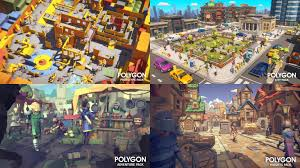Unlocking the Power of High-Poly Assets in Unity
Introduction
Unity, a versatile and powerful engine for game development, offers developers the opportunity to create immersive and engaging experiences. A crucial aspect of this process is the use of high-poly assets. While these assets can significantly enhance the visual fidelity of a game, they also come with resource-intensive challenges. In this post, we'll delve into the benefits, challenges, and best practices for integrating high-poly assets into your Unity projects, equipping you with the knowledge to make informed decisions and optimize your projects.
What Are High-Poly Assets?
High-poly (high-polygon) assets are 3D models with a high level of detail, achieved by having a large number of polygons. These assets are typically used in scenes that require realistic detail and complex geometry, such as in character models, environmental props, or architectural elements.
Benefits of High-Poly Assets
- Visual Realism: High-poly assets offer unparalleled realism and detail, making them ideal for cinematic scenes, photorealistic environments, and high-end games.
- Enhanced Immersion: With detailed models, players are more likely to be immersed in the game world, leading to a more engaging experience.
- Artistic Flexibility: High-poly models provide artists with greater flexibility to create intricate designs and detailed textures.
Challenges of High-Poly Assets
Despite their benefits, high-poly assets can present several challenges, particularly in terms of performance and resource management:
- Performance Impact: High-poly models require more processing power, which can lead to reduced frame rates and longer load times.
- Memory Consumption: These assets can consume significant amounts of memory, affecting the overall performance and stability of your game.
- Optimization Requirements: To maintain performance, developers must employ various optimization techniques, adding complexity to the development process.
Best Practices for Using High-Poly Assets in Unity
To effectively use high-poly assets in Unity, consider the following best practices:
- Use LOD (Level of Detail) Techniques: Implement LOD systems to dynamically adjust the complexity of assets based on their distance from the camera. This can significantly reduce the rendering workload.
- Optimize Meshes: Reduce the polygon count of high-poly assets where possible without compromising visual quality. Tools like Unity's ProBuilder can help in this process.
- Bake Lighting and Shadows: Pre-bake lighting and shadows to reduce real-time calculations. This can improve performance while maintaining visual fidelity.
- Texture Compression: Use texture compression to reduce memory usage without sacrificing quality. Unity supports several compression formats that can be used to optimize textures.
- Use Occlusion Culling: Implement occlusion culling to prevent rendering of objects that are not visible to the camera. This can greatly enhance performance in complex scenes.
- Test on Multiple Platforms: Test your game on different devices to ensure consistent performance. This is crucial when working with high-poly assets, as performance may vary across platforms.
Additional Points to Consider with High-Poly Assets in Unity
To build upon our discussion of high-poly assets in Unity, here are more detailed points to consider for a comprehensive understanding of the subject:
The Role of Shaders
- Custom Shaders: High-poly assets can benefit from custom shaders to create unique visual effects. Shaders allow you to define how materials interact with light, adding additional realism and visual appeal.
- Optimized Shader Usage: While custom shaders can enhance high-poly assets, it's crucial to optimize them for performance. Consider using simpler shaders for distant objects and complex shaders for close-ups.
Data Management and Streaming
- Asset Bundles: When dealing with high-poly assets, consider using asset bundles to manage and distribute large data sets efficiently. This approach allows you to load assets dynamically, reducing memory usage during gameplay.
- Asset Streaming: Unity offers asset streaming, enabling you to load assets only when needed. This can help manage memory and maintain performance when dealing with large high-poly models.
Collaboration and Workflow
- Asset Creation Workflow: When creating high-poly assets, ensure your workflow is optimized for collaboration among artists, designers, and developers. Consider using version control systems like Git to track changes and manage assets.
- Collaboration Tools: Unity supports various collaboration tools to streamline the asset creation process. Tools like Unity Collaborate and Plastic SCM can help teams work together efficiently.
Performance Testing and Profiling
- Use Profiling Tools: Unity's built-in profiling tools allow you to monitor performance metrics like frame rate, memory usage, and CPU/GPU workload. Regularly profile your game to identify bottlenecks and optimize accordingly.
- Automated Testing: Implement automated testing to ensure high-poly assets do not negatively impact performance across different devices and scenarios.
Considerations for Mobile and VR Development
- Mobile Optimization: High-poly assets can be challenging to manage in mobile game development. Use aggressive optimization techniques and LOD systems to ensure a smooth experience on mobile devices.
- VR Considerations: In virtual reality, maintaining high frame rates is crucial for a comfortable experience. When using high-poly assets in VR, focus on performance optimization, efficient culling, and reducing draw calls to prevent VR sickness.
Post-Processing Effects
- Post-Processing Impact: High-poly assets may require post-processing effects for enhanced visual appeal. However, post-processing can be resource-intensive. Balance visual quality with performance by carefully selecting and optimizing post-processing effects.
- HDR and Bloom: When working with high-poly assets, consider using high dynamic range (HDR) lighting and bloom effects to add realism. Ensure these effects are optimized to prevent performance degradation.
Conclusion
High-poly assets in Unity can bring a new level of realism and immersion to your game, but they require careful consideration and optimization. By following the best practices outlined above, you can harness the power of high-poly assets while maintaining performance and resource efficiency. And the best part? As Unity continues to evolve, developers can look forward to even more tools and techniques to create stunning, high-fidelity experiences. The future is bright for high-poly assets in Unity, and we're excited to see what you'll create.
For more topics, see https://bleedingedge.studio/blog/

.png)
.jpg)

Comments
Post a Comment